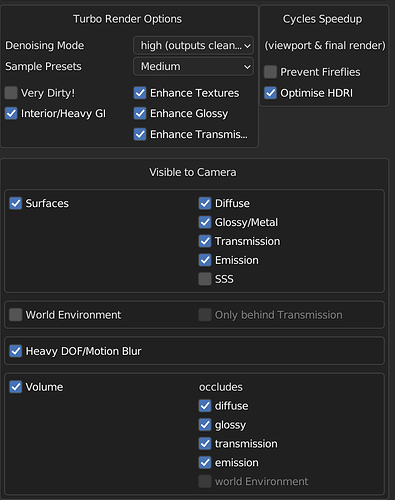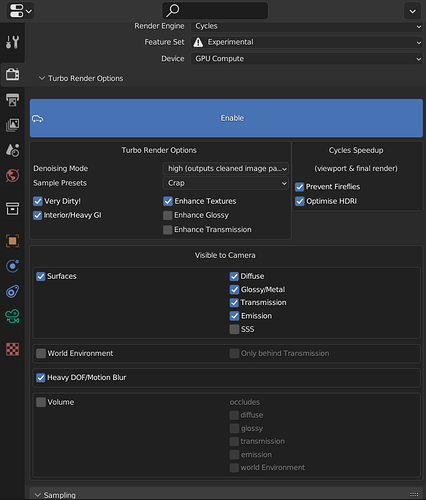Hi mate, I use to use e-cycles but switched to the octane for blender build. Sometimes I want to render in cycles though but dont want to have to open e-cycles. I would rather do it in the octane for blender build by just switching to cycles as my render engine. Will this addon work this cycles in the octane for blender build? I basically want a sped up, high quaility version of cycles I dont have to do much messing around with to get great results with speed and preset simplicity.
Hi. I’ve only tested with the official Blender, but I’d imagine it should work, as it’s unlikely the Octane devs have changed the Cycles and compositor side of things.
Just watched all the way through the youtube videos with a mug of tea and blown away so purchased. Great work mate. Know its personal, but where is your accent from in england?
Cheers dude, some massive improvements coming imminently. Going to test it for a week under all scenarios to make sure I haven’t introduced any issues, and then I’ll release it. I’m originally from Derbyshire in England. In Nottingham now, but still have the Derbyshire accent. It’s not as strong as it used to be. Where I grew up people spoke like this: ‘Allraight Duck aas it gooin’, ‘bin daaan t pub recent?’ ![]()
Mint mate. Im from Durham and could hear a bit of midlands in your accent (my french girlfriend was overlistening while I was watching the videos of TR on youtube and asked “Is he north english?”). Also part of the package that sold me ![]() Looking forward to the updates. Ta.
Looking forward to the updates. Ta.
Ha, awesome, thanks for the purchase ![]()
No, I want to denoise only channels outputs that I choose. Like the denoiser in Blender compositing tools work. Can’t there be simple ne a turbo denoiser node?
Yes it will only denoise the channels you choose in the ‘visible to camera’ section’ For example if you don’t want to denoise the diffuse, then uncheck diffuse before uploading. You can also change these settings in the python expression rather than in the file if you wish. There are some changes to cache folder handling in the next release which will make farm implementation more straightforward in that respect. I’ll keep you posted.
It will also only temporally stabilise passes that have wires connected to them in the compositor. So if you only have the image output of the render layer node connected to the composite node, it will only stabilise the image pass. If you’ve set up the compositor to rebuild the image from passes, then it’ll stabilise those used before they’re used by the rest of the compositor tree. It’ll never stabilise data passes such as denoise data, motion vectors etc.
Ok, I have to check that out once I have sample files.
Cool ![]() You’re going to love this temporal system by the way. It saves a ton of time, and is super intuitive. Can even stabilise multiple scene simultaneously.
You’re going to love this temporal system by the way. It saves a ton of time, and is super intuitive. Can even stabilise multiple scene simultaneously.
I’m assuming that fundamentally you’re using OIDN as the actual noise reduction engine, although you’re using it in a much smarter way than the standard Blender does.
My question is, do you foresee that Turbo Render will work just as well once Blender adopts the new OIDN with GPU acceleration that was just announced recently?
Yes, it uses the OIDN backend, so once GPU acceleration is enabled, Turbo Render will automatically be able to use it ( I might have to add the option dependant on how it’s implemented).
On a side note, I’ve also been doing some research into Intel’s API, and it seems that it’s able to denoise in tiles rather than the full image. I’ve presented it to the Blender devs, and if implemented it’ll mean any size image will be denoisable whilst only ever using 3GB RAM. So fingers crossed on that one. They mentioned it will likely be implemented with full frame compositing.
Hi Michael, just bought TR today.
I was already down on my knees, starting to build a shrine to worship your greatness… when I noticed a little issue. So I thought I better sort that out before I devote myself completely to your genius. ![]()
The issue is caused by haze / a volume. Behind the haze (which is hardly visible, but it is there) I get some strange artefacts. As you can see in the circled area on the picture below. On the left is TurboRender with haze - on the right without.
I went full monty and chose all the volume options I could find. But somehow I must have missed something. (These artefacts also happen, when I deselect all the volume options.)
These are the options I selected:
Is there a way to get rid of these artefacts? If possible without using more samples?
If yes, then TurboRender is a total game changer!!
It’s an amazing tool, anyway. But it would be a real pity if I could not use volumes.
Btw, I did these renders on a 2019 Macbook Pro, CPU only.
Hi @Michael_Campbell, how soon is it going to be, days, weeks, months? Or impossible to say at this point?
Hi, you need to turn on very dirty ![]()
days. I’m doing the final testing now. Need to make a video showing how to use it, get it upoaded and then release ![]()
Nearly ready. Results are really good. Motion blur needs to be disabled before rendering otherwise Blender can’t generate the required vector pass.
Here’s an incredibly difficult to render test scene provided by Alex Weinberg. It was taking 1000 samples without turbo render to get it to a denoisable flicker free state. The below render was done with Turbo Render using just 12 samples (the crap sample preset)!
without temporal (some very bad flicker on the bricks, skateboards, glass and ceiling):
with temporal (flicker dramatically reduced):
The Temporal stage is a non destructive post process carried out during publishing. It also works with Optix or Oidn (not only turbo render).
few more days of testing and it should be ready, all being well.
Oh, I’d probably leave enhance glossy and transmission unchecked. They only make a difference if there are very detailed images feeding the base colours of those materials (like a metal texture for example). Generally they’re going to be a solid colour so can be left off.
Unfortunately none of the mentioned solutions worked. Neither ‘very dirty’ on, nor ‘enhance glossy and transmission’ off helped.
I even tried ultra-denoise mode with high samples. That actually made it worse.
I will explore more and let you know…



